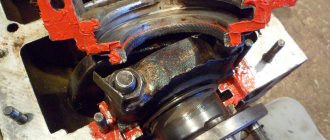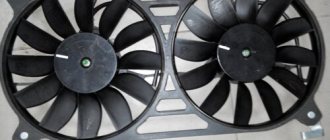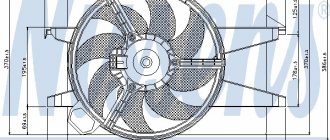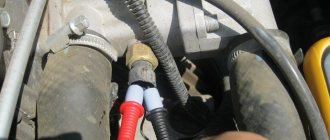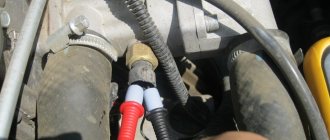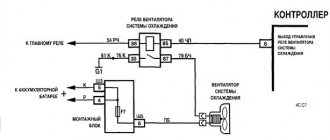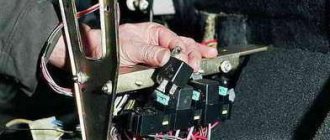A malfunctioning cooling fan is a fairly easy-to-fix problem that you can easily handle on your own. There are not many reasons for this, and any of them can be easily localized and eliminated. In this case, it is not at all necessary to replace the cooling fan of the VAZ 2114. Usually the problem can be solved much easier and cheaper.
Cooling fan functions
The cooling fan of the VAZ 2114 is a DC electric motor with an impeller and is designed for forced airflow of the radiator. This is necessary when the natural air flow through its cells is not enough to effectively cool the engine. If the fan does not work, the coolant and engine may overheat. This can lead to serious problems, some of which may require major engine repairs:
- leakage of coolant through the expansion tank due to its boiling (this is the most harmless consequence);
- burnout of the cylinder head gasket, which will require removal of the engine head;
- engine jamming as a result of expansion of the piston rings;
- damage to the crankshaft liners, which are made of fusible material.
Therefore, while driving, you need to monitor the temperature of the coolant and turn off the engine if it overheats above 100 degrees. You also shouldn't risk operating a car with a faulty cooling fan. If it does not work, then the likelihood of overheating and damaging the engine increases many times over.
How to replace a temperature sensor
Before starting work, you need to partially drain the coolant from the cylinder block.
- Remove the wire.
- Using a 21 wrench, unscrew the temperature sensor.
- Take it off.
- Install the new one in reverse order.
Why the VAZ 2114 cooling fan does not work
The fan electric motor starts working only after the antifreeze temperature in the radiator reaches 100 degrees. To do this, it is connected to the on-board network via a thermal relay. If the coolant temperature is more than 90 degrees, and the fan does not turn on, then the reasons may be as follows:
- faulty fan fuse;
- break or poor contact in the fan motor power supply circuit;
- breakdown of the temperature sensor (cooling fan relay) VAZ 2114;
- poor contact on the temperature sensor connector;
- the fan itself is malfunctioning.
Before starting repairs, it is necessary to find out the cause of the malfunction.
How to find out the cause of the problem
You should start by checking fuse F4 (20A)kre, located on the left under the hood in the mounting block. This fuse also protects the horn power circuit. So, to check it, you can simply press the signal button. If it works, then the fuse is fixed. If not, then the latter should be replaced with a working one.
You can then continue by checking the fan motor itself. To do this, you need to unplug its connector and power the electric motor from the battery directly with wires. If the impeller starts to rotate, then the fan is working. Does the VAZ 2114 cooling fan not work? We continue to search for the cause. The next step is to check the condition of the fan sensor contacts and the integrity of the wires going both to the fan itself and to the sensor (VAZ 2114 cooling fan relay). The sensor is installed so that if it is de-energized, the control unit will start the electric cooling fan in forced operation mode. It's easy to check - just unplug its power connector and turn on the ignition. If the fan starts working, then the relay (sensor) needs to be replaced.
When should you change a cooling fan?
If the VAZ 2114 cooling fan does not turn on, it is not at all necessary to change the entire unit. You can try to repair it by replacing the brushes or bearings. If the cause of its breakdown is a short circuit or break in the winding of the electric motor, it will not be possible to repair the electric motor. In this case, you will have to replace it with a new one.
Where is the fan relay located?
It is located in an additional block.
4 – electric fan relay;
5 – electric fuel pump;
6 – ignition relay.
Relays and fuses may have a different order. Therefore, you need to focus on the color of the wires. The main relay is always located at the bottom. Find the relay that has a thin pink wire with a black stripe coming from it. It comes from the main relay through pin 85. Be careful! Do not confuse this with the red thin wire, which also has a black stripe and extends from the controller. And find a thick white wire with a black stripe (pin 87). This is where the cooling fan relay is located. There is always a fuse next to it. It is an element of the chain.
Replacing the VAZ 2114 cooling fan
Before changing the cooling fan, you must place the car on a level surface and set the parking brake. You should also be sure to disconnect the ground contact from the battery. Otherwise, a short circuit may occur. The cooling fan is replaced as follows:
- Unscrew the screws that secure the air filter cover;
- remove the cover and remove the filter element;
- unscrew the air filter mounting nuts using a 10 mm socket wrench;
- using a screwdriver, loosen the air duct clamp securing the latter to the air flow sensor;
- remove the air duct corrugation;
- unscrew the air intake mounts using a size 8 socket wrench;
- remove the air intake;
- disconnect the fan power connector;
- Using keys 8 and 10, unscrew the 6 nuts that hold the fan casing;
- dismantle the fan casing along with the electric motor and impeller;
- Using a 10 mm socket wrench, unscrew the 3 bolts holding the fan in the casing;
- remove the electric fan;
- insert a new VAZ 2114 cooling fan into the casing;
- tighten the bolts securing the fan to the casing;
- install the casing with the fan in place and tighten it with nuts;
- connect the power connector of the electric cooling fan;
- install the air intake and air filter housing;
- install and secure the air duct corrugation;
- insert the filter element into the filter;
- install the cover and secure it with nuts;
- connect ground to the battery;
- Warm up the engine and check the operation of the cooling fan.
If the fan does not turn on after the engine warms up, all motor batteries should be checked again. A working fan will relieve you of the need to carefully monitor the engine temperature and will allow you not to worry about overheating even in the most severe road conditions.
How to correctly install the VAZ 2109 fan switch button
There are two options - through a relay or using just a switch. The relay connection diagram is simple - you need to connect two wires parallel to the sensor. They both must go to the normally open terminals of the electromagnetic relay. This scheme avoids the presence of high current in the switch.
Two thin wires must be brought out under the dashboard and connected to the contacts of the button (or switch). Thus, a control element for the low-current winding of an electromagnetic relay is installed inside the car, and all high-current circuits are located under the hood.
And now, if the VAZ 2109 fan sensor fails, you just need to press a button to cool the engine. For this purpose, a standard relay with normally open contacts is used. Similar ones are installed on light and electric motor drives. Its price in the store is about 50-70 rubles.
The cost of the fan switch sensor is about 100 rubles. As a result, after spending a couple of hundred and half an hour of time, you will create a reliable system that will not let you down in difficult times.
I will say for myself: after it boiled in traffic a couple of times, due to the fan not turning on, I had to install a regular switch and relay. Unfortunately, nothing was found except the heater fan switch from the six, so I installed it. And now, as soon as I approach a jam, I simply turn on the fan. And I turn it off after stopping. This does not affect maneuverability and speed. Even taking into account that the carburetor nine (holds idle 900-930), no jerks or attempts to stall occur.
But you can, of course, use a different scheme - for example, turn on the VAZ 2109 fan directly with a switch, without using a relay. But this risks the fact that the contacts of the switch will constantly burn out, and its service life becomes much shorter.
Replacement
If you nevertheless come to the conclusion that the problem lies precisely in this element, then you will have to replace it. It is advisable to install a new fan. A used one can fail quite quickly. And it is impractical to repair a damaged one. When replacing, you will have to do the following:
- Disconnect the battery. This will protect you from short circuits and failure of some electronic systems of the machine;
- Remove the side heater casing on the driver's side;
- Under the instrument panel you need to find and disconnect the positive wire going to the fan;
- Unscrew the lowest heater mounting nut. The negative wire of the motor is removed from the stud;
- The hood opens and the seal is removed. Remove both screws securing the fan casing;
- The casing is removed;
- Unscrew the fan mounting screws. There are only 2 of them, for this you will need a Phillips screwdriver;
- Unscrew the 5 screws securing the air intake grilles. They are located in front of the windshield. Next, remove them;
- The fan is slightly lifted and removed from the mounts by sliding it forward (towards you);
- The fan housing is rotated 90° and removed;
- Before installing a new motor, you should thoroughly clean the compartment from any dirt accumulated there;
- Assembly is carried out in reverse order.
How to perform a check on injection VAZ cars
It is quite possible that this can also be done on other cars, but I will not vouch for the result, since I tested it with personal experience only on domestic injection cars VAZ (2109-2115), Kalina, Priora, etc.
To quickly check whether your fan is working or not, just follow these steps:
- open the hood of your car
- turn on the ignition
- we find the coolant temperature sensor (most often it is located on the thermostat housing)
- disconnect the electrical connector from it
DTOZH VAZ
If the fan motor is working properly, it should turn on immediately when you remove the “terminal” from the sensor. If this does not happen, then the fan is faulty.
Yes, you can, of course, remove the connector directly from the fan itself and check everything using the battery power supply, but you must agree that this is a much more labor-intensive process than removing the connector from the temperature sensor.
Diagnostics
The primary task is to identify the cause of the breakdown and assess your own capabilities in a specific situation.
Let's start with something simple and move on to something more complex:
- We check the fuse (F-7 with a voltage of 30 A), which is responsible not only for the heating system, but also for the operation of: the cigarette lighter, heated mirrors, glove compartment lights, and headlight washers. Therefore, when this fuse blows, all of the above devices refuse to work. If it is working, we move further along the chain.
- Turn on the car's ignition and switch the speed control to positions 1, 2, 3 in order. If the fan does not work in any of these positions, we move on.
- If the heater motor turns on after the car engine has warmed up, the problem is a faulty ignition relay. Solved by replacing the relay.
- If the heater motor refuses to work in any mode, there remains one malfunction - the heater motor itself.
The process of dismantling the fan motor
For the final verdict, let’s apply “+” directly to the motor by removing the positive wire terminal from the motor. If the motor does not come to life, the last thing you can try is to try to clean the place under the ground mount on the electric motor. Often this place oxidizes and the contact weakens.
Liquid pump (pump)
On a VAZ 2114 car, the engine cooling system works due to the fact that the antifreeze is in motion and under pressure higher than atmospheric pressure. The movement is created using a pump installed on the right wheel side directly in the engine block. Driven by a timing belt. Examination:
Drain the antifreeze from the system (there are two holes for this). This should only be done on a cooled engine!
Unscrew the three bolts securing the plastic cover to the engine block.
Use a key set to “17” to loosen the roller nut. This allows the timing belt to loosen.
Remove the belt and look at its condition. If it is “eaten” from the outside (by 1-3 mm), then this indicates that the belt is slipping due to the pump being worn out.
Take the pump pulley with your hands and try to move it, rotate it in different directions. If there is play or jamming, the pump must be replaced.
Otherwise, the cooling system of the VAZ 2114 (injector or carburetor, it doesn’t matter at all) will not work correctly.
Reasons for fan failure
There are a number of reasons why the fan sensor can eventually fail other than the sensor itself. Therefore, they should first be excluded to make sure that the sensor is to blame.
Reasons for fan failure include:
- The fan has failed. It can wear out, lose integrity, and receive mechanical damage. It will be more expensive to replace it compared to the sensor, but there is no choice.
- The chain has broken. When testing a sensor, the method of closing two of its contacts is usually used. But if the wiring circuit is damaged, this will not be possible, and due to inexperience, all the blame will be placed on the regulator.
If checking the contacts does not produce results, the fan does not respond, try connecting its contacts directly to the battery.
Resistor fault
As noted above, the resistor is designed to change the level of resistance of the current supplied from the generator to the heating system fan. In the VAZ-2114, using a switch, you can ensure the fan operates in three modes. In the extreme position, the fan is powered by a voltage equal to the nominal voltage of the vehicle's on-board network, providing maximum power output. In the intermediate position of the switch, the level of the supplied voltage is reduced due to one of the two resistor windings, the resistance of which increases by 0.20 Ohms. In the third mode, the second winding also comes into operation, due to which the total resistance of the resistor increases by 0.80 Ohms, reducing the fan rotation speed to a minimum.
If the windings burn out, regardless of the switch position, the fan operates only at full power. The inability to switch fan operating modes is evidence of a resistor malfunction.

